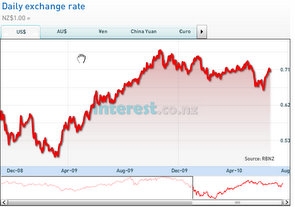
By Mike Jones*
The NZD/USD has spent the past 24 hours mooching about in a sideways 0.7040-0.7120 range.
The initial excitement about China’s re-working of its Yuan policy has tended to fade over the past 24 hours, replaced with more pessimism about Europe’s debt woes.
The NZD/USD enjoyed a brief pop above 0.7100 yesterday afternoon following the PBOC’s decision to drop the mid-point of the USD/CNY’s trading band 0.4% to 6.7980. But with the USD/CNY subsequently trading higher, these gains were quickly unwound.
We suspect the markets’ preoccupation with the daily fix of the USD/CNY midpoint will soon fade, as folk get used to the idea appreciation in the CNY will be allowed to occur at only a gradual pace.
Overnight, global stocks markets snapped their 10-day winning streak, weighing on risk appetite and “growth-sensitive” currencies like the NZD.
European equity indices slipped 0.4-1.0% and the S&P500 is currently down around 1.5%.
Not only was US data fairly uninspiring (US home sales fell 2.2% vs. +6.0 expected), but a slew of worrying credit news rekindled fears over the health of the European banking sector. EUR/USD ground down from 1.2320 to nearly 1.2260, dragging NZD/USD back towards 0.7050.
While NZD/EUR was propelled to 3-year highs around 0.5770 in the wake of the softer EUR, NZD/GBP was sent spiralling in the other direction.
UK markets were heartened by the fact last night’s ‘emergency’ budget appeared tough enough to stave off a UK ratings downgrade.
Indeed, the UK’s deficit is now forecast to plunge from 11% of GDP to 2.1% by 2014. NZD/GBP tumbled from around 0.4820 to nearly 0.4750 in the wake of the announcement.
Today’s current account will probably be another good-looker, with the annual deficit reducing even further, to around 2.7% of GDP, from 2.9% in Q4.
Still, we suspect it will take a rip-roarer for NZD/USD to test initial resistance towards 0.7150.
Today’s USD/CNY fixing will again attract some attention, so be on your guard at 1:15pm NZT.
Majors
Last night’s moves in currencies were a bit of a mixed bag. With the USD caught in a sideways shuffle, most of the majors chopped about inside their recent ranges. The initial euphoria surrounding China’s decision to relax the CNY’s peg to the USD faded noticeably overnight. ‘Commodity-linked’ currencies enjoyed a brief spurt higher after the PBOC set USD/CNY’s mid-point 0.4% lower than Monday (at 6.7980).
However, gains proved fleeting as USD/CNY closed above the PBOC’s mid-point, amid rumours of large scale buying by Chinese banks. The UK’s ‘emergency’ budget announced last night appeared to get the nod of approval from UK markets.
Indeed, the budget went over and above most expectations in its aim of addressing the hole in the public finances.
The UK’s deficit was forecast to fall from 11% of GDP to 2.1% by 2014, public spending will be slashed by 25% over 4 years, VAT will rise from 17.5% to 20%, and banks will be slapped with a £2bn levy.
While it’s too early to expect a clean bill of health from the ratings agencies, Fitch were quick to say the budget would “materially strengthen confidence in the UK’s AAA rating”, if delivered upon.
UK government bond yields fell in response; the 10-year gilt fell to 8-month lows around 3.4% at one point during the night. EUR/GBP slipped from 0.8360 to below 0.8280 and GBP/USD jumped to almost 1.4850. In stark contrast, Europe hit the headlines for all the wrong reasons.
Sure, the June German IFO index hit a 2-year high of 101.8 (101.2 expected). But a wealth of worrying credit news rekindled fears over the European banking sector, weighing on the EUR.
French bank Credit Agricole said it will take a €400m write-down on Greek exposures, Fitch’s downgraded BNP Paribas, and S&P announced it had raised estimates for loan losses for Spain's banking sector.
As a result, EUR/USD traded heavily for most of the night, hitting an overnight low of 1.2260.
US data wasn’t particularly inspiring either. While the April house price index recorded a 0.8% rise in April (0.3% expected), existing home sales tumbled 2.2% in May – far worse than the +6.0% expected.
US 10-year yields dipped about 5bps in response and USD/JPY skidded to 90.50, from above 91.00. US stocks fell 1.1-1.5%, keeping “growth sensitive” currencies like AUD, CAD and NZD under pressure for most of the night. Looking ahead, the focus for markets is firmly on tomorrow morning’s (6:15am) FOMC rate decision.
We suspect a downbeat statement from the Fed would actually support the USD owing to its “safe-haven” status. However, gains may well be capped by resistance at the 87.00 region on the USD index. Support is seen towards 85.30.
* Mike Jones is part of the BNZ research team. All its research is available here.
No chart with that title exists.

We welcome your comments below. If you are not already registered, please register to comment.
Remember we welcome robust, respectful and insightful debate. We don't welcome abusive or defamatory comments and will de-register those repeatedly making such comments. Our current comment policy is here.